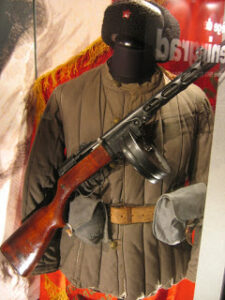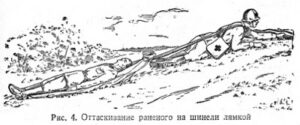The other day I was reading an article about small unit actions. In the introduction it was explained that the men and women recruited as Soviet soldiers were used to living close to nature and tolerated and even thrived under conditions that would defeat German soldiers.
The questions that spring to mind are how was this done and how can this be applied to modern soldiers? I made a few posts on the Soviet soldier’s equipment some months back. It is apparent that the Soviet soldier of the Great Patriotic War got by with relatively little equipment. Let us start by looking at his clothing.
The basic Soviet field dress was a pull-over tunic and a pair of long breeches. This was an outfit that European fighters have used for many centuries. The Soviet tunic and loose trousers would not seem that unfamiliar to a Viking, Celt, Saxon or a medieval peasant.
Like many uniforms of the Second World War, it was constructed of wool, which has the advantage that it does not chill the wearer that much if wet. The Soviets also had a cotton version for summer use.
The tunic and trousers were worn directly over the underwear. The underwear seems to have been a long-sleeved undershirt and long johns for both summer and winter use. Both of these items were issued in summer and winter forms. Both forms were made from cotton, the difference being the winter version was fustian with a fluffy nap on the inside. The use of cotton for both the summer and winter underwear is interesting. I suspect this may have been selected to simplify mass laundering of items. Theoretically the Soviet soldier exchanged his underwear for a fresh set every ten days.

There were relatively few items for use in sub-zero temperatures. Each soldier had a greatcoat, which was also used instead of a blanket when sleeping so was carried all year. When not worn the greatcoat was usually carried rolled up and worn across the chest
The distinctive telogreika padded jacket and vatnie sharovari trousers were made from cotton and filled with cotton wool. It was cheap and simple to manufacture and very effective. Its thickness and wearing the garment over woollen clothing helped counter some of the disadvantages of cotton if it got wet. Below zero conditions meant that rain was seldom a problem. Telogreika and vatnie sharovari are often seen as outermost garments but were intended to be used under the greatcoat or sheepskin coats.

I am unsure as to how the telogreika and vatnie sharovari were carried if they were not being worn. They look like they would be too bulky to carry in the soldier’s backpack. Perhaps they were rolled up inside the greatcoat. Possibly they were treated as baggage items and only issued when the winter tunics were. Sheepskin coats might be worn in winter instead of the greatcoat. Some books claim the sheepskin coats were for cavalry and tankers but photographs prove that many other units acquired them. The greatcoat or sheepskin and telogreika were worn with ushanka fur hats, balaclavas, mittens/gloves and valenki felt overboots. With these few items the Soviet soldier operated in minus 50 conditions.
The rest of the Soviet soldier’s equipment also forms a relatively short list.
• A weapon and ammunition and grenades.
• An entrenching tool: numerous uses including as a close combat weapon.
• A canteen.
• Gas mask case and contents.
• A rain cape (plashch palatka)
• A simple haversack (myeshok).
The haversack contained a bag of tent pegs and a pole-section for constructing shelters. Contents also including a mess pail, shaving kit, soap, toothbrush and weapon-cleaning kit. There is no bayonet scabbard since bayonets were always carried fixed to the weapon.


The rain cape might be carried folded up in the haversack. It could also be rolled around the outside of the greatcoat roll or carried as a roll instead of the greatcoat. These rolls were also used to carry items. The cape is another item that would be familiar to a viking etc. Effectively it is a rain-resistant cloak and thus could be used for warmth as well as protection from the rain. The rain cape was a heavier item than modern ponchos but was also more robust. It could be used to drag a wounded man to safety, for example. One cape could be used as a shelter and another as a ground-cloth to accommodate two men, who slept together in their greatcoats. Capes could be combined to form larger shelters.


The haversack also carried rations. While I have found descriptions of what a Soviet soldier would carry, I have yet to find indications of the quantities.
Other notable items used were one or two-piece camouflage outfits designed to be worn over the field uniform. Generally these were used by scouts, snipers and engineers. White coveralls were used for camouflage in winter.
Post-war, a few interesting wrinkles were added to this basic equipment. In another post I have detailed the spetsnaz use of cotton string vests and coats with a “skirt” extension piece.
The equipment listed above is very brief compared to that of a modern soldier or outdoorsman. Part of the reason for this is that some items such as the greatcoat and raincape were multipurpose. The list above is probably incomplete. Historical sources often do not mention items such as tinderboxes and matches since it was inconceivable to the author that a peasant or outdoorsman would need to be told to carry these.
Some items we have now simply did not exist then.
Personal night-vision equipment and radio communicators had not yet been developed. The use of flashlights was restricted in the Soviet army, whilst the modern soldier often finds himself searching dark places. There is no compass and map-case in the standard Soviet field kit since navigation was for NCOs and officers.
Very often the Soviet soldier did without many of the things we regard as essentials such as kipmats, blankets, sleeping bags and tents.
The last sentence brings me to another thing that should be considered. What items on your equipment list are truly essential and what are just useful and nice to have?